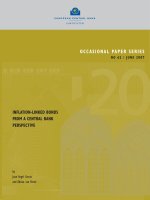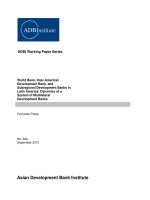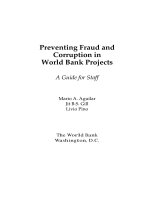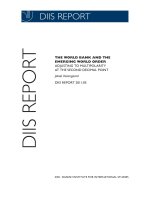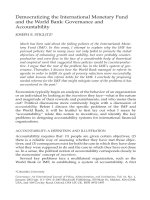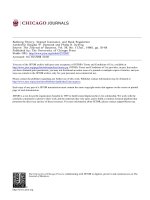Top 1000 world Bank 2012 pptx
Bạn đang xem bản rút gọn của tài liệu. Xem và tải ngay bản đầy đủ của tài liệu tại đây (1.39 MB, 9 trang )
114
|
The Banker
|
July 2012
Top 1000 world Banks
cover story
While European banks
count the cost of the
eurozone sovereign debt
crisis, China is leading
the emerging markets
into a new era of banking
dominance. But the
established markets of
the US and Japan should
not be forgotten. Philip
Alexander reports.
Top 1000 world Banks
July 2012
|
The Banker
|
115
cover story
ABN Amro and WestLB. The latter will exit our table
next year as an EU-mandated break-up plan is com-
pleted, with the remaining core of the bank renamed
Portigon Financial Services.
The UK is by no means immune from the woes of
the eurozone, and UK banks are hardly in better shape
overall. Total Tier 1 capital in the country actually
shrank in 2011, with Royal Bank of Scotland dropping
out of the top 10 banks worldwide. While total pre-tax
profits slipped far less than in the eurozone, by about
8.2%, Brazil has now overtaken the UK in terms of prof-
its earned, despite having an asset base that is less than
one-fifth the size of that in the UK.
But the UK banking sector is itself a divided story.
While Lloyds crashed back into losses due to its provi-
sioning for payment protection insurance compensa-
tion claims, two UK banks, HSBC and Barclays, were
among the top 20 largest profits in the 2012 rankings.
Of course, both earn a significant part of their income
outside the UK, including HSBC’s universal banking
operations across emerging markets, and Barclays’ US
investment banking operations built up from its pur-
chase of the US arm of Lehman Brothers in 2008.
Greek shockwave
The cause of Europe’s troubles is well known. Greek
banks, together with the Cypriot banks whose Greek
operations are larger than those in their home market,
feature prominently among the largest losses this year.
No less serious has been the gradual acknowledgement
of the damage caused to Spain’s cajas (savings banks) by
the collapse of a domestic real estate bubble.
An EU bail-out package for Spanish banks was
under negotiation at the time of going to press, and the
need for it is clear. The bank mergers driven through by
the authorities in 2011 cannot overcome the scale of the
losses. Bankia, Catalunya Caixa and Grupo Unnim all
disclosed losses equivalent to more than half their entire
capital base, while Banco CAM, whose attempted
merger with Liberbank failed last year, will need totally
recapitalising. Simply plugging the holes left by loan
losses will not be enough – any rescue plan will need to
think hard about which banks have sufficient potential
business to return to viability. Interestingly, while
Bankia’s operating income collapsed by more than 60%
in 2011, Catalunya Caixa actually increased its underly-
ing revenues by almost 70%.
Italy and Portugal are also heavy losers. But the
damage at Italy’s two largest banks looks temporary –
I
t will come as no surprise that 2011 was the year
when the eurozone crisis dragged the global
banking sector backwards. Assets and Tier 1
capital in The Banker’s Top 1000 World Banks
ranking continue to grow, although at a much
reduced rate to last year’s ranking. But aggregate profits,
which had staged two years of recovery since the finan-
cial crisis, reversed by 1%, to stay only just above the
$700bn mark.
The process of capital build-up demanded by regu-
lators in the wake of the crisis also appears to be
approaching completion, as the aggregate capital-to-
assets ratio this year is almost exactly constant on last
year, at 5.36%. The heaviest capital increases in previ-
ous years had been among the top 25 banks, whereas the
change in the capital-to-assets ratio for those largest
banks this year is in line with the Top 1000 as a whole,
gaining just 0.1%.
Last year, we asked the question about whether the
performance of banks in the largest markets was sus-
tainable. In Europe at least, the answer this year is an
emphatic no. In total, 49 banks reversed from a profit in
2010 to a loss in 2011, of which all but 13 are based in EU
countries. By contrast, only 14 banks worldwide fell
from a profit to a loss in 2010. Of the 25 largest losses at
previously profitable banks, only one (Hudson City Ban-
corp in the US) comes from outside the EU. The scale of
the damage is so severe that aggregate pre-tax profits in
the eurozone were just $2.1bn, compared with $85.5bn
in last year’s ranking.
On a more positive note, 34 banks returned to profit
after losing money in the previous ranking – compared
with 105 banks in 2010. The US is the major success
story, accounting for half the banks that have re-entered
profit as the clean-up from subprime makes progress.
But there are also some banks in western Europe that
were synonymous with the first round of the financial
crisis but are now on the road to recovery, including
July 2012
|
The Banker
|
115
2011 2010 Change (previous year)
Tier 1 capital 5,746 5,434 5.7% (10.6%)
Total assets 107,233 101641 5.5% (6.4%)
Pre-tax profits 702 709 -1.0% (77%)
Profits/Tier 1 12.23% 13.1%
Return on assets 0.66% 0.69%
Top 1000 aGGreGaTes ($Bn)
Source: www.thebankerdatabase.com
Tier 1 capital-to-assets ratio
% by ranking year
4.2
4.4
4.6
4.8
5.0
5.2
5.4
1211100908070605040302
4.62
4.5
4.54
4.53
4.45
4.53
4.32
4.43
5.14
5.35
5.36
Source: www.thebankerdatabase.com
116
|
The Banker
|
July 2012
Top 1000 world Banks
cover story
provided the EU is able to prevent Italy descending into
a full-blown sovereign debt crisis. The losses come
mostly from one-off items, in particular extremely con-
servative goodwill write-offs on the value of past acqui-
sitions at home and to a lesser extent in central and
eastern Europe. UniCredit has already offset much of its
loss with a rights issue staged in January 2012, while
Intesa Sanpaolo raised capital in 2011.
Further afield, Dexia’s rescue and dismemberment
by the French and Belgian governments was triggered
by its exposure to the eurozone periphery, while Erste
Group Bank suffered a much smaller loss after winding
up a portfolio of credit default swaps written on euro-
zone sovereigns. Its smaller peer Volksbank took a hit of
E160m from its exposure to the Greek private sector
involvement (PSI) restructuring, and a far larger loss on
its operations in Romania and Hungary. The latter were
part of its Volksbank International subsidiary sold to
Russia’s Sberbank.
One of the largest losses caused by Greece is entirely
hidden in our ranking. Hypo Real Estate (HRE) in Ger-
many returns to profit this year, for the first time since it
was nationalised by the German government in 2009 on
account of catastrophic losses on US securitisation
assets. But Germany’s state financial support fund
SoFFIN took a hit of E8.9bn on Greek government debt
that was previously on HRE’s own balance sheet, which
was transferred to its ‘bad bank’ vehicle FMS Wertman-
agement for winding down in 2010. It is perhaps not
widely realised that the German taxpayer effectively
participated in the restructuring of Greece’s debts to the
private sector in March 2012.
asseT qualITy early warnInGs
With the collection of impairment data improving, the
Top 1000 should provide an increasingly valuable early-
warning indicator for any deteriorations in asset quality.
Of course, impairment has a certain degree of discretion
– banks do not always provision fully for non-perform-
ing assets, and also choose whether to impair at-risk
assets. The long delays in disclosing the true level of
non-performing loans (NPLs) at Spanish banks are a
reminder that impairment figures may not always reveal
all that they should. But regulators worldwide are taking
an increasingly tough line, giving banks less leeway to
massage the true state of their portfolios.
We have tracked impairments as a percentage of
total operating income, to give an indication of banks’
ability to absorb the pain of impaired assets through
their underlying revenues. Unsurprisingly, Greek, Cyp-
riot, Irish and Spanish banks all feature prominently.
Source: www.thebankerdatabase.com Source: www.thebankerdatabase.com
Rank T1000 Bank Country Latest
rank profit ($m)
Rank T1000 Bank Country Latest
rank profit ($m)
1 160 National Bank of Greece Greece -17,364
2 126 Dexia Belgium -15,127
3 28 Intesa Sanpaolo Italy -12,428
4 21 UniCredit Italy -9,998
5 239 Piraeus Bank Group Greece -9,674
6 109 Banco Financiero y de Ahorros Group Spain -6,373
7 187 Alpha Bank Greece -6,123
8 77 Banca Monte dei Paschi di Siena Italy -6,092
9 18 Lloyds Banking Group UK -5,476
10 243 Cyprus Popular Bank Cyprus -5,306
11 119 Dexia Bank Belgium (Belfius) Belgium -2,776
12 102 UBI Banca Italy -2,761
13 183 Catalunya Banc (CatalunyaCaixa) Spain -2,590
14 302 Bank of Cyprus Cyprus -1,749
15 153 Millennium bcp Portugal -1,581
16 212 Hudson City Bancorp US -1,255
17 273 Osterreichische Volksbanken Austria -1,153
18 180 Banca Popolare di Milano Italy -901
19 394 Grupo Unnim Spain -733
20 129 Caixa Geral de Depositos Portugal -693
21 312 WGZ Bank Germany -560
22 277 Banco Portugues de Investimento (BPI) Portugal -424
23 75 Erste Group Austria -417
24 924 Attica Bank Greece -323
25 420 Belarusbank Belarus -299
1 63 ABN Amro Group Netherlands 872.09
2 144 Zions Bancorporation US 522.39
3 231 77 Bank Japan 338.66
4 128 Hypo Real Estate Holding Germany 332.53
5 361 Associated Banc Corp US 183.43
6 489 Cathay Bank US 151.41
7 68 Landesbank Baden Wurttemberg Germany 151.39
8 353 Hypo Alpe Adria Bank Austria 109.46
9 774 Pacwest Bancorp US 87.50
10 247 SNS Bank Netherlands 76.34
11 794 Boston Private Financial Holdings US 57.87
12 729 Western Alliance Bancorporation US 48.34
13 169 WestLB Germany 47.87
14 682 BBCN Bancorp US 42.78
15 676 First Midwest Bancorp US 41.07
16 656 Butterfield Bank Group Bermuda 40.40
17 543 Sterling Financial Corporation US 39.13
18 778 Kita Nippon Bank Japan 37.95
19 931 CM Florida Holdings US 36.89
20 779 Central Pacific Financial Corp US 36.57
21 972 Ameris Bancorp US 31.65
22 933 Hanmi Financial Corporation US 28.88
23 800 Pinnacle Financial Partners US 28.50
24 991 Daito Bank Japan 23.60
25 893 Sandnes Sparebank Norway 18.57
25 larGesT losses from prevIously
profITaBle Banks
25 larGesT profITs from prevIously
loss-makInG Banks
Country Tier 1 Assets Pre-tax profits
($bn) ($bn) ($bn)
US 1051.9 13,341.0 131.5
Eurozone 1721.6 40,895.0 2.1
China 781.5 13,533.2 206.3
Japan 600.9 13,075.5 60.0
UK 440.8 9999.5 32.9
Brazil 123.8 1729.2 33.1
reGIons By ToTal TIer 1/ToTal
asseTs/ToTal pre-Tax profITs 2011
Source: www.thebankerdatabase.com
118
|
The Banker
|
July 2012
Top 1000 world Banks
cover story
118
|
The Banker
|
July 2012
There are a few other less predictable developments.
Denmark’s FIH Erhvervsbank is already in discussion
with the Danish authorities, having hived off its real
estate arm in February 2012 as part of a restructuring
plan. In general, Scandinavia is in excellent health, with
Sweden and Finland both among the 10 countries with
the lowest ratios of impairment to income.
Slovenia is beginning to look like a forgotten crisis
on the fringes of the eurozone, with four of the country’s
banks all among the top 25 impairments as a proportion
of total operating income. Only Greece, Cyprus, Ireland
and Belgium (on account of the Dexia crisis) are in a
worse condition based on this indicator.
Historically, poor asset quality used to be much
more common in emerging than in developed markets.
While we have long observed the steady improvement in
the performance of emerging market banks, this is no
time for complacency. Several high-growth markets
have experienced sharp deteriorations in asset quality
this year, including Brazil and Nigeria, where impair-
ments more than doubled, and Vietnam, where they
more than tripled. In all three cases, total impairments
are still fairly low, at less than 20% of operating income,
but a note of caution is clearly advisable if asset quality
continues to slide at this pace.
At the other end of the scale, there is perhaps hope
for the eurozone from Iceland, where net impairments
were negative this year. Having been through the pain of
restructuring in 2008 and 2009, the rebuilt banking
sector is now writing back onto the balance sheet the
recoveries from previously written-off loans. Despite the
political turmoil in 2011, Egypt is also among the 10
Top 1000 world Banks
cover story
Source: www.thebankerdatabase.com
Source: www.thebankerdatabase.com
Rank Country Impairment (% of
total operating income)
1 Greece 302.13
2 Cyprus 242.48
3 Belgium 124.88
4 Ireland 121.61
5 Slovenia 91.30
6 Belize 64.42
7 Portugal 62.94
8 Spain 44.37
9 Ukraine 41.42
10 Angola 37.04
Top 10 counTrIes for ImpaIrmenT
charGes
Source: www.thebankerdatabase.com
Rank Country Impairment (% of
total operating income)
1 Iceland -0.83
2 Switzerland 1.01
3 Hong Kong 1.33
4 Japan 1.37
5 Panama 3.42
6 Sweden 3.61
7 Bermuda 4.10
8 Egypt 4.26
9 Guatemala 4.64
10 Finland 4.70
lowesT 10 counTrIes for ImpaIrmenT
charGes
countries with the lowest rate of impairments to operat-
ing income, suggesting a very conservatively run bank-
ing sector that is not yet heavily exposed to lending into
the real economy.
a new BankInG GIanT
There may be plenty of pessimism in this year’s ranking,
but we should not neglect the positive stories. The most
obvious and radical shift that we have been tracking for
the past few years is the rise of China, and its status in
this year’s ranking is extraordinary. China now equals the
US in having four banks in the top 10 by Tier 1 capital,
and a Chinese bank has entered the top three worldwide
for the first time, as ICBC displaces HSBC.
China ranks 10th in the world for return on capital,
with the nine countries ahead of it all being emerging
markets. Chinese capital and assets are both rising very
fast, at almost 28% for Tier 1, and more than 23% for
assets. The high return on capital is achieved on a capi-
tal-to-asset ratio of 5.8%, much healthier than western
Europe or Japan.
While there are concerns about China’s real estate
market, and whether arrears on corporate and municipal
lending are adequately reported, Chinese banks appear to
have a vast cushion of profits with which to tackle problem
loans as they arise. The scale of profits in China is one of
the most striking developments of the past five years. In
our 2007 ranking (financial year ending 2006), the US,
Middle East and Latin America were noticeable outper-
formers in terms of profitability. North American banks
had a 15.9% share of global assets, but a 26.5% share of
profits. Western Europe was already an underper-
1 243 Cyprus Popular Bank Cyprus 433.62
2 160 National Bank of Greece Greece 348.17
3 439 FIH Erhvervsbank Denmark 343.35
4 186 Irish Bank Resolution Corporation Ireland 275.55
5 239 Piraeus Bank Group Greece 267.99
6 187 Alpha Bank Greece 262.59
7 183 CatalunyaCaixa Spain 220.44
8 924 Attica Bank Greece 211.81
9 109 Banco Financiero y de Ahorros Spain 198.11
Group (Bankia)
10 65 Allied Irish Banks (AIB) Ireland 179.58
11 940 Abanka Vipa Slovenia 178.99
12 918 Southwest Bancorp US 149.75
13 302 Bank of Cyprus Cyprus 139.84
14 184 Osterreichische Volksbanken Austria 123.18
15 742 United Community Banks US 117.71
16 886 Hypo Tirol Bank Austria 115.46
17 229 Irish Life & Permanent Ireland 112.70
18 394 Grupo Unnim Spain 100.97
19 786 Nova Kreditna Banka Maribor dd Slovenia 88.61
20 153 Millennium bcp Portugal 85.03
21 486 Nova Ljubljanska Banka (NLB) Slovenia 81.72
22 419 Commercial Bank of Kuwait Kuwait 77.30
23 362 Ukreximbank Ukraine 71.62
24 909 Gorenjska Banka Slovenia 68.08
25 546 Banco Internacional do Funchal Portugal 66.58
Rank T1000 Bank Country Impairments
rank (% of operating
income)
Top 25 ImpaIrmenTs rankInG
120
|
The Banker
|
July 2012
Top 1000 world Banks
cover story
120
|
The Banker
|
July 2012
former, with a huge 58.3% share of assets but only 46.2%
of profits. But Asia-Pacific was also punching below its
weight, with 21.9% of assets but only 18.9% of profits.
Roll forward to the 2012 ranking, based on end-2011
results (or March 2012 for most Japanese banks), and
most asset shares are constant. The exception is that Asia-
Pacific has grown to 33.5%, entirely at the expense of
western Europe, now down to 45%. But in terms of prof-
its, western Europe has almost disappeared, with a share
of just 6.3%, while Asia-Pacific now accounts for a stag-
gering 53.9%. China’s profits are 30% of the global total,
compared with assets that are just 13%. But this is not
solely a Chinese story, with Indonesia accounting for only
2.5% of assets worldwide, but more than 10% of profits.
Of course, it pays to be cautious, and while China’s
capital-to-assets ratio is high by developed market
standards, it is significantly lower than other major
emerging markets. Brazil’s ratio is more than 7%, those
for Mexico and Russia are more than 8%, and Indonesia
and Turkey are pushing 9%.
GoInG where The GrowTh Is
That note of caution notwithstanding, it is very clear that
emerging market growth prospects will be superior to
those in western Europe for some time. The top 25 coun-
tries for return on capital are all emerging markets, with
the exception of commodity-driven economies in Aus-
tralia and Canada.
However, before European executives rush for the air-
port, they will notice that many of the top countries for
return on capital are not easy markets in which to operate.
Banking penetration may be low, allowing high margins
and room for growth, but it is low for a reason. Pakistan,
which slips a little from its top spot but is still the fourth
Top 1000 world Banks
cover story
%
■ Western Europe
■
Asia-Pacific
■ North America
■
Middle East
■ Latin America
■
Central and Eastern Europe
■ Africa
Central and Eastern Europe includes Central Asia.
Latin America includes the Caribbean.
Source: www.thebankerdatabase.com
%
■ Western Europe
■ Asia-Pacific
■ North America
■ Latin America
■ Middle East
■ Central and Eastern Europe
■ Africa
Central and Eastern Europe includes Central Asia.
Latin America includes the Caribbean.
Source: www.thebankerdatabase.com
%
■ Western Europe
■ North America
■ Asia-Pacific
■ Middle East
■
Latin America
■ Central and Eastern Europe
■ Africa
Central and Eastern Europe includes Central Asia.
Latin America includes the Caribbean.
Source: www.thebankerdatabase.com
%
■ Asia-Pacific
■ North America
■ Latin America
■ Western Europe
■ Middle East
■ Central and Eastern Europe
■ Africa
Central and Eastern Europe includes Central Asia.
Latin America includes the Caribbean.
Source: www.thebankerdatabase.com
Global share of assets, 2007 ranking
Global share of assets, 2012 ranking
Global share of profits, 2007 ranking
Global share of profits, 2012 ranking
122
|
The Banker
|
July 2012
Top 1000 world Banks
cover story
122
|
The Banker
|
July 2012
best performer, is fraught with political and operational
risks, which have kept the banking sector very small com-
pared with the size of the domestic population.
Argentina, which jumps from fifth to top of the
return on capital ranking, suffers from entrenched high
inflation, which policy-makers appear unwilling to
tackle. Asset growth of more than 50% in 2010 looked
unsustainable, even from a low base, but this has at least
moderated to just 12.3% in 2011 without doing profits
any harm. That should provide reassurance that Argen-
tine banks are not pushing too far into high-risk lending
activities, but slower asset growth would presumably
also constrain revenue growth in the future.
Perhaps the stand-out story is Poland, the only
country among the top 25 by return on capital to com-
bine a highly profitable banking sector with the relative
institutional security of EU membership (but thankfully
not eurozone membership). Little wonder that Banco
Santander, with its home market in trouble, bought the
country’s fourth largest bank, Bank Zachodni WBK,
from Allied Irish Banks in 2010. It then followed up by
merging Zachodni with Kredyt Bank, owned by Bel-
gium’s KBC, in May 2012, to build the country’s third
largest bank.
In fact, ownership of foreign assets is already a
major advantage for many European banking groups,
including those with some of the most troubled home
jurisdictions. In our table of top profits among foreign-
owned subsidiaries, we have excluded banks in Aus-
tralia, New Zealand and Scandinavia, which effectively
have multiple home markets. The top foreign subsidi-
ary, HSBC Hong Kong, is also almost a second home for
the UK-headquartered bank, whose very name high-
lights its historic role in Asian markets.
By contrast, other important foreign acquisitions
are much more recent. Santander in particular has a
string of very profitable banks in Latin America among
the top earning foreign subsidiaries, which contributed
almost 70% of group pre-tax profits, while Spanish peer
BBVA’s holdings in Mexico and Venezuela comprised
more than 60% of its profits. BBVA also has a 25% stake
in highly successful Turkish bank Garanti. Italy’s Uni-
Credit is another to benefit from a Turkish subsidiary,
Yapi Kredi, while profits from UniCredit in Russia are
just outside the top 25 for foreign-owned subsidiaries.
Of course, control of Turkish Finansbank is also a saving
grace for National Bank of Greece, whose home market
is a source of catastrophic losses at the moment.
emerGInG Banks cross Borders
This last story, however, is a stark reminder that foreign
acquisitions are not an option for the worst-hit banks
that are now desperately short of capital. Indeed, the
trend is heading the other way, as banks in western
Europe are forced to sell subsidiaries as part of state-
backed restructuring plans. Russia’s Sberbank has been
a prime beneficiary of this, buying the central and east-
ern European network of Austria’s Volksbank in 2011,
and now closing in on the acquisition of DenizBank in
Turkey from Belgium’s rescued Dexia.
Indeed, Europe’s woes are a unique opportunity for
the most successful banks in emerging markets that are
in danger of outgrowing their home market to pursue a
more cross-border strategy. In addition to Sberbank,
Latin American banks appear to be on the rise, with
Chile’s Corpbanca buying Santander’s Colombian oper-
ations. HSBC announced sales of several Latin Ameri-
can units during 2012, all to Colombian banks – Colombia,
Peru, Uruguay and Paraguay to GNB Sudameris, with
Costa Rica, El Salvador and Honduras going to Banco
Davivienda. Of course, both HSBC and Santander retain
vast international networks, so these sales are about
rationalisation rather than retreat.
In general, smaller banks are now increasing
Top 1000 world Banks
cover story
1
Amount of capital injection included in calculation of pro-forma Tier 1 capital. Actual recapitalisations may vary.
2
EFG Eurobank Ergasias statutory Tier 1 capital not disclosed. Shareholders’ equity, including 2011 losses, was $1.13bn at Dec 31, 2011.
3
National Bank of Greece received a higher amount of HFSF bonds totalling $9.61bn on May 28, 2012.
4
Cyprus Popular Bank Tier 1 capital based on total shareholders equity, actual figure not disclosed.
5
Bank of Cyprus’s pro-forma Tier 1 capital calculation does not include PSI impairment related tax benefit of $299m recorded in Q1 2012.
Key: HFSF – Hellenic Financial Stability Fund; PSI – private sector involvement (Greek sovereign debt restructuring).
GREECE
EFG Eurobank Ergasias (EFG Group)
2
12/11 Greece 6479 n/a
2
Not
included
Not
included
n/a n/a n/a n/a n/a
National Bank of Greece 12/11 Greece 5965 $8.928bn from HFSF
3
Included Included 80% -3074 Included Included 80%
Alpha Bank 12/11 Greece 4884 $2.458bn from HFSF Included Included 79% 2426 Included Included 79%
Piraeus Bank Group 12/11 Greece 3368 $6.017bn from HFSF Included Included 76.5% -2650 Included Included 76.5%
Emporiki Bank (Crédit Agricole) 12/11 Greece n/a n/a n/a n/a n/a 1625 Included Included 77%
Attica Bank 12/11 Greece n/a n/a n/a n/a n/a 368 Included Included 71.6%
CYPRUS
Cyprus Popular Bank 12/11 Cyprus 3284 $2.329bn rights issue underwritten by the
Republic of Cyprus plus $160m Tier II exchange
to create core capital plus $84m existing eligible
contingent convertible bonds
Included Included 76.4% 778
4
Included Included 76.4%
Bank of Cyprus 12/11 Cyprus 2599
5
$207m share capital increase (rights issue) and
$559m exchange of Convertible Enhanced
Capital Securities (CECS), completed in March
2012
Included Included 83% 2392 Included Included 83%
Hellenic Bank 12/11 Cyprus n/a n/a n/a n/a n/a 703 Included Included 70%
Bank Date Country Pro forma
Tier 1 ($m)
Capital injection/funding commitment included in
pro forma Tier 1
1
Current
year’s loss
included or
not?
PSI
impairment
included or
not?
Greek
sovereign
debt % hair-
cut included
in Tier 1
calculation
Statutory
Tier 1 ($m)
Current
year’s loss
included or
not?
PSI
impairment
included or
not?
% haircut
included
in Tier 1
calculation
Bank accounTInG for Greek sovereIGn resTrucTurInG
126
|
The Banker
|
July 2012
Top 1000 world Banks
cover story
126
|
The Banker
|
July 2012
their capital more rapidly than the average for the Top
1000. While global capital rose 5.7%, the threshold for
entry into the ranking, at $284m in Tier 1 capital,
increased more than 11%. This would suggest that the
shift in the global banking landscape toward regional
emerging market players is set to continue.
noT much GoodwIll
However, foreign subsidiaries do not always bring prof-
its. In central and eastern Europe especially, a combina-
tion of the economic fall-out from the eurozone and local
political risks have triggered significant losses at the par-
ent company level. Erste Bank, Volksbank, UniCredit
and Intesa Sanpaolo have all taken substantial write-
downs on operations in Romania, Hungary and (in the
case of UniCredit) Ukraine.
These are not necessarily the product of loan losses,
but rather because the banks had been carrying signifi-
cant goodwill valuations dating from their acquisitions
of these subsidiaries. Under increasing scrutiny from
regulators, all these banks had acknowledged that the
prospects for these subsidiaries were insufficient to jus-
tify the high goodwill values.
Such write-offs are at least one-off losses – espe-
cially for Volksbank, which has now sold its Hungarian
operations to Sberbank. Worryingly, the bank was
forced to retain its Romanian subsidiary, which the
Russian bank refused to buy owing to fears over asset
quality. The good news is that many central and eastern
European subsidiaries are generating operational prof-
its, and should start to yield greater value for their par-
ents in the future.
In the Baltic states that were severely hit by the
financial crisis and a local property collapse in 2008,
subsidiaries of Sweden’s SEB and Swedbank have
returned to profit. One bank with a less certain future is
Ukrsibbank, BNP Paribas’s subsidiary in Ukraine. The
bank lost $448m in 2011, equivalent to almost 70% of
its Tier 1 capital, and is now too small to appear in our
country ranking unless recapitalised by its parent. It
goes without saying the Greek subsidiaries are hardly in
favour either, with Crédit Agricole’s Emporiki Bank los-
ing more than $2bn in 2011, despite which the group
still managed to generate overall profits of $5.1bn.
don’T forGeT esTaBlIshed markeTs
For all the focus on growth markets, it is noticeable that
countries at the epicentre of the 2008 financial crisis,
namely the US and UK, can still generate handy returns
for foreign investors. Santander subsidiaries in the US and
UK each generated profits of about $2bn last year, while
US subsidiaries contributed about $800m each to Royal
Bank of Scotland and BNP Paribas. Overall, the US mar-
ket has returned to its pre-crisis status as an outperformer
in terms of profitability, with a 15.6% share of global assets
generating a 23.4% share of worldwide profits.
Top 1000 world Banks
cover story
Rank Country Return on capital
1 Argentina 42.82
2 Peru 40.41
3 Indonesia 36.08
4 Pakistan 35.96
5 Russia 30.46
6 Poland 29.89
7 South Africa 28.02
8 Vietnam 27.35
9 Brazil 26.74
10 China 26.39
11 Venezuela 25.97
12 Australia 25.31
13 Morocco 24.39
14 Turkey 23.72
15 Malaysia 23.33
16 Thailand 23.17
17 Chile 22.80
18 Iran 22.75
19 Qatar 22.39
20 Colombia 22.38
21 Canada 20.75
22 Mexico 20.6
23 India 20.59
24 Lebanon 20.37
25 Panama 18.96
Top 25 counTrIes for reTurn on
capITal (%)
Source: www.thebankerdatabase.com
Rank Bank Country Pre-tax Parent Parent
profits ($m) country
1 HSBC Hong Kong 11,766 HSBC UK
2 Banco Santander Brasil Brazil 4752 Banco Santander Spain
3 Grupo Financiero BBVA Mexico 2207 BBVA Spain
Bancomer
4 Santander Holdings USA US 2166 Banco Santander Spain
5 HypoVereinsbank Germany 2089 UniCredit Italy
6 Santander UK UK 1949 Banco Santander Spain
7 Absa Group South Africa 1745 Barclays UK
8 Yapi ve Kredi Bankasi Turkey 1540 UniCredit Italy
9 Grupo Financiero Banamex Mexico 1470 Citi US
10 Standard Chartered Bank Hong Kong 1282 Standard Chartered UK
(HK)
11 Grupo Financiero Santander Mexico 1171 Banco Santander Spain
12 UnionBanCal Corp US 1095 Bank of Tokyo- Japan
Mitsubishi UFJ
13 Bank Pekao Poland 1051 Unicredit Italy
14 HSBC Bank Brasil Brazil 1020 HSBC UK
15 Banco Santander Chile Chile 1003 Banco Santander Spain
16 Banco de Chile 965 Citi US
17 HSBC Bank Canada Canada 936 HSBC UK
18 Ceska Sporitelna Czech Rep 856 Erste Group Bank Austria
19 BancWest Corporation US 805 BNP Paribas France
20 Citizens Financial Group US 778 RBS UK
21 BBVA Banco Provincial Venezuela 747 BBVA Spain
22 Standard Chartered Bank India 699 Standard Chartered UK
India
23 DenizBank Turkey 659 Dexia/Sberbank Belgium/
Russia
24 Bank Austria Austria 658 UniCredit Italy
25 CSOB Czech Republic Czech Rep 650 KBC Group Belgium
Top 25 profITs for foreIGn-owned
suBsIdIarIes
Source: www.thebankerdatabase.com
128
|
The Banker
|
July 2012
Top 1000 world Banks
cover story
128
|
The Banker
|
July 2012
Another banking market that is perhaps easily for-
gotten is the former giant of Japan, whose banks domi-
nated the top 10 two decades ago. In this year’s ranking,
only Mitsubishi UFJ retains that status, with Mizuho
and Sumitomo Mitsui squeezing into the top 20.
With a capital-to-assets ratio of 4.6%, they do not
have a huge proportion of surplus capital. But Japanese
banks did record impairments equivalent to just 1.4%
of total operating income in 2011, despite the damage
done to the local economy by the earthquake and tsu-
nami in March. This has helped Japanese banks in the
2012 Top 1000 to show profits of $60bn, double those
of the UK and up almost 33% year on year. The improv-
ing performance after the stagnation that followed
Japan’s own financial crisis in the early 1990s holds out
hope to western Europe.
The strong savings culture in Japan means its banks
are also highly liquid, with the top three banks all enjoy-
ing loan-to-deposit ratios of well below 90%. In fact, the
major challenge for Japanese banks is a shortage of new
lending opportunities in their home country, as the pop-
ulation dwindles and economic growth remains low.
This makes them natural candidates to expand over-
seas, and there are signs of movement down that route.
In the US, Mitsubishi is using UnionBanCal, a subsidi-
ary since 1975, to take advantage of the post-crisis land-
scape and acquire further assets on the west coast,
including two banks in 2010 and Pacific Capital Ban-
corp in 2012. UnionBanCal generated profits of more
than $1bn in 2011.
Top 1000 world Banks
cover story
Bank Country Tier 1 cap in previous ranking $m Notes
During 2011, change included in 2012 ranking
Banco Base Spain 7223 Merger failed, Liberbank Group & Banco CAM separated
Deutsche Postbank Germany 7194 Acquired by Deutsche Bank
Bank of Moscow Russia 4942 Acquired by VTB Bank
Marshall & Ilsley Corp US 4430 Acquired by BMO
Banco Pastor Spain 2616 Merged – see Banco Popular Espanol
EON Bank Malaysia 1341 Acquired by Hong Leon Bank
Deutsche Schiffsbank Germany 1257 Acquired by Commerzbank
BAC Credomatic Panama 930 Acquired by Banco de Bogota
NewAlliance Bancshares US 917 Acquired by First Niagara
Friesland Bank Netherland 767 Acquired by Rabobank
Bank Islam Malaysia Malaysia 669 Acquired by BIMB Holdings
Wilmington Trust Corp US 648 Acquired by M&T Bank Corporation
Caja Cantabria Spain 521 Merged into Liberbank Group
Sterling Bancshares US 509 Aquired by Comerica
Compagnie Financiere E de Rothschild France 429 Group reorganisation – see Banque Privee Edmond de
Rothschild Group
Novacaixagalicia Spain 372 Renamed NCG Banco
Center Financial Corporation US 291 See BBCN Bancorp
Danvers Bancorp US 283 Acquired by People’s United Financial
Rural Bank Australia 270 Acquired by Bendigo and Adelaide Bank
During 2012, change not included in ranking
Kuxtabank Spain 7394 (estimated) Merger of BBK, Kuxta and Vital
Banca Civica Spain 6129 Acquired by CaixaBank
Banco Cam Spain 3178 Acquired by Banco Sabadell
PT Bank Danamon Indonesia Indonesia 2376 Bid for acquisition from DBS Group Holdings
DenizBank Turkey 1930 Acquired by Sberbank Russia
Pacific Capital Bancorp US 715 Acquired by Mitsubishi UFJ Financial Group
Kredyt Bank Poland 696 Merged with Bank Zachodni WBK
merGers, acquIsITIons and resTrucTurInGs
Source: The Banker, Dealogic
accounTInG for a crIsIs
In addition to generating heavy losses, the eurozone sov-
ereign crisis has also provided some interesting dilem-
mas for our research team. During the 1980s, US
regulators responded to signs of growing trouble in the
savings and loan sector by loosening accounting stand-
ards in an attempt to give these banks time to trade their
way out of trouble.
In many cases, the ploy failed badly as losses only
increased, and it is perhaps worrying that the European
Banking Authority (EBA) seems to be straying down the
same route in a bid to shore up Europe’s banking sector.
Not all Greek and Cypriot bank data submitted to the Top
1000 appeared to take full account of the losses suffered
on Greek sovereign debt, which prompted us to request
that these banks fill in an additional survey to explain
their results. The responses to that survey can be found on
page 122, and the crucial message is that the Greek banks
submitted their capital ratios on a pro-forma basis, incor-
porating the capital injections they expected to receive
from the EU as part of the country’s rescue package.
The Hellenic Financial Stability Fund began the
capital injection in May 2012, but its completion is still
subject to political uncertainty in the wake of elections
in June and the incoming government’s intention to
partially renegotiate terms with the EU. In the case of
Cyprus, the government is underwriting a $2.3bn rights
issue by Cyprus Popular Bank, but at the time of going to
press the Cypriot authorities had indicated that they
would need EU support to carry this through.
130
|
The Banker
|
July 2012
Top 1000 world Banks
cover story
Rank Bank Country % increase Total RWA
in market RWA change %
Rank Bank Country % decrease Total RWA
in market RWA change %
1 Banco Bradesco Brazil 355.64 11.95
2 BNP Paribas France 261.95 -1.1
3 UniCredit Italy 240.38 -2.04
4 National Australia Bank Australia 233.92 0.08
5 Crédit Agricole France 218.42 1.76
6 Deutsche Bank Germany 178.55 6.67
7 Banco do Brasil Brazil 158.74 8.88
8 Rabobank Group Netherlands 151.87 -1.43
9 Société Générale France 140.78 0.97
10 UBS Switzerland 136.36 21.05
1 Allied Irish Banks (AIB) Ireland -63.72 -17.41
2 Bank of Ireland Ireland -44.71 -17.8
3 Scotiabank Canada -42.4 11.35
4 Banco Santander Spain -34.16 -9.44
5 Woori Financial Group South Korea -22.22 3.27
6 Royal Bank of Scotland UK -20.96 7.84
7 Royal Bank of Canada Canada -12.01 5.22
8 Desjardins Group Canada -9.35 3.06
9 KDB Financial Group South Korea -7.77 12.08
10 Nationwide Building Society UK -6.04 -0.38
Top 10 Increases In markeT rIsk Top 10 decreases In markeT rIsk
RWA – risk-weighted assets
Source: www.thebankerdatabase.com
RWA – risk-weighted assets
Source: www.thebankerdatabase.com
What is also striking across the board is that the
haircuts applied on Greek sovereign debt holdings, and
the way that they have been applied, are not at all uni-
form across the Greek and Cypriot banks. This begs the
question of whether some banks have given themselves
a sufficient safety margin in their capital-raising plans,
especially as the real economy is also likely to remain in
the doldrums for some time.
Clearly, there will be similar concerns about
accounting at the Spanish cajas (savings banks), which
took several years to acknowledge the scale of losses suf-
fered. Several cajas do not report NPLs to the Top 1000
at all, while others are recording levels of about 3%. By
contrast, some of the banks already subject to heavier
official intervention and rescue by the government
restructuring fund FROB, such as Liberbank and Banco
CAM, have disclosed NPL ratios well into double fig-
ures. This implies there could be further losses to come
in the Spanish banking sector. In theory, allowing banks
to book expected future rescue packages in their capital
is intended to reassure depositors, but the Spanish expe-
rience suggests that opaque accounting merely increases
mistrust in the financial sector as a whole.
Another complicated accounting story is Dexia,
which was broken into French and Belgian components
as part of its 2011 bail-out. Losses on eurozone debt
exposure have only been partially recognised, and
the capital ratio still includes money expected to be
generated by the sale of more valuable assets. The
DenizBank deal suggests those expectations may be
realistic, but market conditions for selling bank assets
are hardly favourable.
We naturally favour financial transparency, and
would note the correlation between financial problems
and the non-submission of data to the Top 1000. Last
year, Bank of Moscow did not submit data. After it was
bought by Russian peer VTB Bank in 2011, the combined
group required a government capital injection of more
than $14bn to cope with losses on Bank of Moscow’s loan
book. This year, EFG Group, the Luxembourg parent
company of Greece’s Eurobank, has not submitted group-
level data, although we have obtained some data for the
Greek subsidiary. Readers may want to take a closer look
at the list of banks that did not submit data on page 258.
One of the most notable omissions is the German
savings banks, the sparkassen. We have mentioned in
the past that data submission from this sector is
extremely patchy, and this year we adopted a new
approach, simply including the aggregate figures for the
whole sector supplied to us by the German Savings Bank
Association (DSGV) in the Germany country listing.
The DSGV justifies this method of reporting because
there is a mutual guarantee on all its members, so depos-
its in any single bank are safe as long as the association
as a whole is solvent. Our response would be that most
sparkassen are ultimately owned by municipal taxpay-
ers, who should surely have a right to know whether
their local savings bank is performing adequately or not.
TIGhTenInG The rules
While accounting standards may be slipping, capital reg-
ulation is set to tighten up with the advent of Basel III.
Much has been made of the impact that this will have on
the weighting of market risk, which was allegedly under-
estimated using Basel II methodology.
As European banks gradually switch methodology
in reporting their accounts, those with large derivatives
businesses, such as the three largest French banks,
Deutsche Bank and UBS, have all seen sharp rises in
market risk-weighted assets. Brazil has also begun to
move to more rigorous capital rules, with two Brazilian
banks high on the list of increased market risk-weights.
By contrast, banks restructured after the crisis that
have been on a steady deleveraging process have reduced
market risk exposure substantially, including the Irish
banks and the UK’s Royal Bank of Scotland. But for all
the concerns on the trading floor, it is noticeable that
market risk is still a very small component of total risk-
weighted assets. Hence banks such as BNP Paribas and
UniCredit can record large increases in market risk, but
still lower their total risk-weighted assets. Given the
impact that financial market volatility has been having on
bank results, it is open to question whether even Basel III
is yet able to capture the true levels of market risk on the
balance sheets of the most complex banking groups.
The research for The Banker’s Top 1000 rankings was
carried out by Adrian Buchanan, Guillaume Hingel,
Charles Piggott, Valeriya Yakutovich, Alberto Berardi
and Bart Thomas.
130
|
The Banker
|
July 2012


